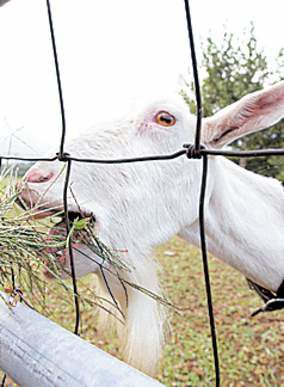Goat meat and dairy products
Published 5:00 am Thursday, June 30, 2011

- Goat meat and dairy products
To describe goat meat, milk or cheese as “goaty” is not considered complimentary. Juniper Grove Farm, a Redmond goat cheese producer, goes so far as to describe its chevre as “not goaty.”
But local goat meat and dairy farmers say it’s possible to create a mild, sweet taste in their products, which are not only delicious but healthy.
Goat meat is gaining attention as a lower-fat alternative to beef and even chicken. And goat milk has for some time been known to be easier to digest than cow milk.
“Many … people have a collective memory of a terrible tasting goat. That is not really the case anymore,” said Nicolle Timm, the creator of centraloregon locavore.com, an online local farmers market.
But first, the skinny about the fat.
Nutritional differences
Annie Williamson, a registered dietitian from Bend Memorial Clinic, said there’s a significant difference in fat content between goat meat and other meats.
“It’s lower in everything, pretty much — calories, fat, saturated fat. Those are all great,” said Williamson. “Protein-wise, the amount of protein is pretty similar.”
On the dairy side, goat milk has a different chemical structure than cow milk. Its fat globules are smaller. Goat milk is a good choice for anyone who is lactose intolerant or just struggling to digest cow milk, Williamson said.
Goat milk has less lactose, or milk sugar, than cow milk, she said. Goat milk is used by people who have any number of gastrointestinal issues.
The amount of protein is similar between goat and cow milk.
However, when it comes to calories and fat, goat milk is comparable to whole milk, whereas cow milk comes in a skim or low-fat variety. Jamie Fitch, a registered dietitian for the Oregon State University Extension Service, said a cup of goat milk contains 168 calories, while whole cow milk provides 146 calories. Goat milk has 10 grams of fat. Whole cowmilk has 8 grams and 1 percent milk has 2 grams, she said.
Meat
Patricia Moore, an owner of Sand Lily Farm in southeast Bend, raises South African Boer goats. Before 1993, goat meat in the United States came from old dairy goats or someone’s backyard goat, Moore said. South African Boer goats are the new meat on the market, and she’s not the only one who raises them in Oregon and across the country.
“South African Boer goats are like the Black Angus of cattle, versus Holsteins, which is a milk cow. You don’t eat milk cows,” she said.
“The world has known about goats forever,” she said. Goat droppings fertilize pastures. Goats don’t overgraze, she said, they wander and nibble weeds, shrubs and grass.
The Oregon State University Extension Service website reports that goat is the most frequently consumed meat worldwide. In the United States, its production is growing. It’s a livestock enterprise that small farmers can efficiently manage. It also appeals to the country’s growing diverse populations that consume goat.
It’s a big seller with the Muslim and Hispanic cultures, Moore and others said. Goats don’t come with religious or cultural taboos like pork and beef, Moore said.
Moore sells her meat through some speciality markets such as Newport Market and local farmers markets, where she tends to offer free samples for those curious about the taste. She describes it as a subtle, earthy flavor that is sweet and mild. It’s a dark meat like red meat or dark turkey, but it tastes nothing like gamey venison, she said.
Dairy
Tiffany Newman, who runs Tumbleweed Farm out toward Alfalfa, said worldwide, more people drink goat milk than cow milk, but in this country, “cows’ milk is the hands-down favorite.”
“Goats’ milk picks up flavors much easier than cows’ milk. The goats must be fed a more strict diet to keep goats’ milk sweet and non-goaty. The way the milk is handled — stainless steel milking utensils, a quick chill time for the milk, proper cleaners for the milking supplies — eliminates the goaty taste,” she said.
Some goat milk sold in stores has an off-putting taste, she said. But when potential customers come to her farm and taste her raw, unpasteurized milk, they tell her “it tastes just like milk!” she said. It’s creamy, sweet and delicious and “straight from the family farm the way it was consumed for thousands of years,” she said.
Pasteurized goat milk is sold in stores. Raw milk is typically purchased on a milking farm.
It is possible to pasteurize raw milk at home, noted Glenda Hyde, an OSU extension community health instructor. (Instructions: http://extension .oregonstate.edu/deschutes/raw-milk). Pasteurization is a time-to-temperature recipe that aims to preserve the freshest taste while killing bacteria.
Consumers should be aware, according to Hyde, that raw goat milk can contain E.coli. It’s not common, she said, but it’s often children or people with compromised immune systems who are drawn to goat milk, and those are the same people who are more susceptible to harmful bacteria. The same warning applies to raw milk and soft cheeses, she said.
Goat cheese in America has grown into a niche specialty more popular than goat meat or milk.
Pierre Kolisch, owner of Juniper Grove Farm in Redmond, describes goat cheese as having a more mineral taste. Some of his fresh chevre has a hint of lemon. He used the term “fruity” like an apple or pear, but tart.
Some people say goat cheese is too expensive, but Kolisch said it’s similar to other cheeses that are handmade. In general, cow milk can be processed into cheese on an industrial scale, year round, whereas he’s running a seasonal business.
Looking for local goat products?
Try Central Oregon Locavore at www .centraloregon locavore.com.






